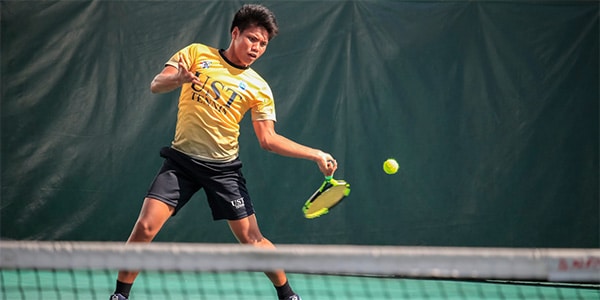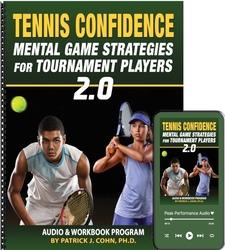
Do You Play to Win in Tennis?
Before we identify the differences between the two mindsets, let’s examine the similarities.
In both mindsets, “playing to win” and “playing not to lose,” players strongly desire to win. Another similarity is that players with these mindsets tend to have strong work ethics and practice with a high degree of intensity.
The difference between the two mindsets is the approach to winning. Players with a “play not to lose” mindset want to win but fear losing. Conversely, players with a “play to win mindset also want to win, believe they can win, and look for a way to win.
When you have a “play not to lose” mindset, you primarily focus on the negative, making mistakes and losing. During matches, you are tight and distracted.
You are so fearful of hitting the ball long that you actually hit the ball long. The fear of double-faulting causes you to double fault. You play cautiously. Instead of you going for shots, you play it safe, trying just to get the ball over the net.
This cautious style of play leads you to set up your opponent to hit winners throughout the match. When you feel the match slipping away, you feel frustrated, angry, and hopeless. When you play not to lose, the result most often is a loss.
Play to Win Mindset
On the other hand, you play to win, you have a positive mindset, and you feel confident. You are mentally immersed in the game and playing without consciously thinking.
You know you will make mistakes and lose points, but you maintain a strong belief in your abilities. Even when you double fault, you move on and feel confident about winning the next point.
You are swinging the racquet freely and playing aggressively. You feel energized, mentally tough, physically strong, and poised. Your match strategy is to play each point to the best of your ability.
When you play to win, you focus less on winning the tournament and more on competing for each point.
Elena Rybakina, ranked 23rd, won her first Grand Slam title at Wimbledon in 2022, beating No. 2 Ons Jabeur, 3-6, 6-2, 6-2. Rybakina battled back after a set down and won 12 of the next 16 games for the victory.
After the match, Rybakina commented that she was locked in and focused on playing to win after the first set.
RYBAKINA: “I was going to fight to the end.” Meanwhile, Jabeur admitted she was focused on ‘not losing’ during the second set.
JABEUR: “I told myself, ‘Don’t lose the second set.’”
The ultimate difference between winning and losing was their mindset. Both players wanted to win, but Rybakina’s playing-to-win approach was the deciding factor.
Summary of the Differences:
Players with a Play-Not-to-Lose Mindset:
- Fail to make comebacks under pressure
- Have difficulty closing out matches
- Are more anxious during sets
- Are primarily focused on the result of the match while playing
- Hit a higher percentage of unforced errors
- Imagine worst-case scenarios
- Feel more fatigued towards the end of matches
- Play it safe during close points
- Fall apart after mistakes
- Experience intense emotional reactions after bad line calls
- Choke under pressure
Players with a Play-to-Win Mindset:
- See themselves winning during close matches
- Play clutch under pressure
- Are excited to play
- Immerse themselves at the moment
- Hit a higher percentage of winners
- Focus on best-case scenarios
- Feel energized throughout the match
- Go for it and take more calculated risks
- Maintain their composure during tough matches
- Get ready for the next point after mistakes and bad calls
- Play their best against tough competition
The first step in changing your mindset is to realize that it’s your choice…
Evaluate past performances and examine your mindset under challenging circumstances. Do you try to avoid losing?
Start by trying one simple approach. Start every point and hit every ball with a positive intention of what you want to do in the point or with the ball. But be flexible as it might not always work out in your favor.
Enlisting one of our expert mental coaches can help you through this process is also helpful to improving your mental game.
Related Articles for Tennis Focus:
- Stay Mentally Tough During Matches
- How to Assess Your Game After Losing Matches
- How Iga Swiatek Resets After a Bad Match
Tennis Confidence 2.0: Mental Game Strategies for Tournament Players

“Tennis Confidence: Mental Game Strategies for Tournament Players” is Dr. Cohn’s program to help tennis players, coaches, and instructors improve the mental game of tennis is just 8 easy to learn sessions. Tennis Confidence: Mental Game Strategies for Tournament Players Audio and Workbook program is ideal for any junior, collegiate, and tour professional player. Tennis coaches and instructors would also be wise to teach the strategies in “Tennis Confidence 2.0.”
Tennis Confidence is a complete mental training program developed Dr. Cohn. You learn the same strategies Dr. Cohn teaches his personal students to help them improve mental toughness and consistency – from managing unrealistic expectations to coping with perfectionism. Read more about Tennis Confidence Program>>